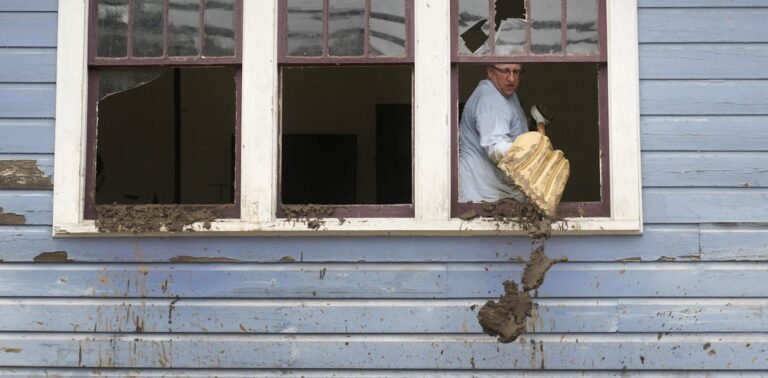The trauma of natural disasters doesn’t end when the storm or fire is gone, or even when communities are reunited and homes have been rebuilt.
For many people, disaster displacement has long-term consequences that are often not obvious or considered in disaster relief decisions.
we are studying public policy and disaster response. To better understand the ongoing challenges disaster victims face – and how officials can respond more effectively – we analyzed US Census Bureau surveys that ask people nationwide about their experiences of disaster displacement, as well as their stress and anxiety.
The results show how recovery from disasters such as hurricanes, wildfires, tornadoes and floods involves more than rebuilding, and how already vulnerable groups are at greatest risk of harm.
Millions are displaced every year
The Census Bureau Household pulse survey has been continuously collecting data on people’s social and economic experiences since 2020. Starting in late 2022, it specifically asked respondents if they had been displaced from their homes by natural disasters.
Nearly 1.4% of the US adult population reported being displaced in the previous year, which equates to more than 3 million Americans. The most common cause of these displacements was hurricanes, accounting for nearly one-third of displacements.
Some groups faced a greater chance of being displaced by natural disaster than others.
The probability of displacement was above average for people with incomes less than $50,000 (1.9% of this population displaced), people with disabilities (2.7%), African Americans (2.3%), and Latinos/Hispanics ( 1.8%), and for those who identified their sexual orientation as gay/lesbian, bisexual, something else or said they did not know (2.2%).
Displacement problems go beyond immediate evacuation. People may need to stay in temporary shelters such as stadiums, churches or disaster relief areas. During this time, they may not be able to work and earn an income. Others who have nowhere else to go may return to damaged homes after the storm is over.
Many people displaced by a hurricane faced weeks without power or without access to enough food, clean water or other basic necessities. After being displaced, 64% of adults said they lacked electricity some or all of the time, 37% did not have enough food, 29% did not have drinking water, and 25% reported experiencing unsanitary conditions some or all of the time. time.
The absence of adequate clean water or electricity can expose people to disease and other health risks, in addition to the stress of dealing with damage, displacement and uncertainty about the future.
About 36% of the displaced stayed outside their homes for more than a month. Almost 16% of them said they were never able to return. Vulnerable groups, especially people of color and the disabled, were less likely to return home quickly.
Health effects
Also displaced heaps on stress and creates instability. People displaced by the storms may be bouncing between the homes of family members, hotel rooms or even vehicles as they wait to return to a damaged home. They might have lost jobs or you cannot find temporary housing nearby, creating feelings of uncertainty about the future.
People who feel their safety or security is threatened more likely to experience mental stress and, potentially, post-traumatic stress disorder. The effects can accumulate over time and have long-term health consequences. Chronic stress can contribute to hypertension and heart disease and make rebuilding lives even more difficult as people struggle with more than just the damage around them.
The Household Pulse Survey also collects information on the symptoms of anxiety and depression experienced by individuals.
Among those displaced by a hurricane, 38% reported experiencing generalized anxiety, much higher than 23% of the nondisplaced population.
Similarly, 33% of those displaced experienced symptoms of major depressive disorder compared to 18% of the non-displaced population.
Better policies for long-term recovery
The results of the survey highlight the need to quickly restore water and electricity to homes after disasters. The results also show that priority is given to communities least able to afford displacement.
Studies have shown that low-income communities often wait longer for power to be restored after hurricanes. Research shows that these communities and other disadvantaged groups also face higher levels of displacement after disasters.
Beyond immediate responses to a disaster, the research suggests that federal, state, and local policymakers should consider long-term assistance for both housing recovery and health care.
AP Photo/Brittany Peterson
Currently, the Federal Emergency Management Agency focuses primarily on providing short-term disaster relief. Most of its disaster funding goes to evacuation, temporary shelter for the displacedemergency supplies, insurance and reconstruction of community infrastructure. While other federal programs supply reconstruction assistance to individualsthey do not adequately address the long-term challenges, in our view.
Some ways the government could help include providing targeted cash transfers ensuring the rebuilding of vulnerable householdsinvesting in affordable and climate resilient housing that can limit losses in future disasters and fund long-term mental health services for disaster survivors at free or reduced cost.
As the climate warms, extreme storms are becoming more frequent in every region of the country. This increases the risks and the need for policymakers to prepare communities to limit disaster damage and recover afterwards. We believe that rebuilding lives will require long-term support, both to build more resilient homes and infrastructure and to recover from trauma.
